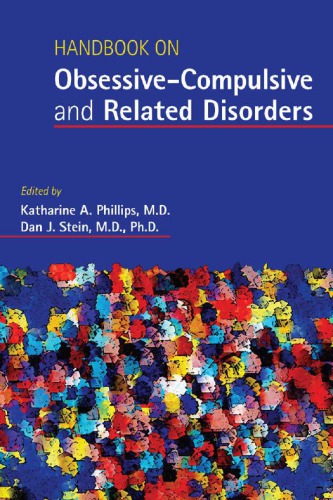کتابچه راهنمای اختلالات وسواس اجباری و مرتبط ۲۰۱۵
Handbook on Obsessive-Compulsive and Related Disorders 2015
دانلود کتاب کتابچه راهنمای اختلالات وسواس اجباری و مرتبط ۲۰۱۵ (Handbook on Obsessive-Compulsive and Related Disorders 2015) با لینک مستقیم و فرمت pdf (پی دی اف)
| نویسنده |
Dan J. Stein M.D. Ph.D., Edited by Katharine A. Phillips M.D. |
|---|
| تعداد صفحهها |
312 |
|---|---|
| نوع فایل |
epub, pdf |
| حجم |
2 Mb |
| سال انتشار |
2015 |
89,000 تومان
معرفی کتاب کتابچه راهنمای اختلالات وسواس اجباری و مرتبط ۲۰۱۵
کتاب راهنمای اختلالات وسواس فکری-اجباری و اختلالات مرتبط اولین کتاب در نوع خود است که طبقه بندی جدید DSM-5 را منعکس می کند، که دیگر اختلال وسواس فکری اجباری (OCD) را به عنوان یک اختلال اضطرابی تعریف نمی کند، بلکه آن را با شرایط مرتبط طبقه بندی می کند. امروزه به عنوان اختلالات وسواسی جبری شناخته می شوند. این تغییر اساسی شواهد فزاینده ای را تأیید می کند که این اختلالات مرتبط و متمایز از سایر اختلالات اضطرابی هستند و هدف آن کمک به پزشکان برای شناسایی و درمان بهتر افراد مبتلا به OCRD است. تعدادی از نویسندگان کتاب در توسعه DSM-5 شرکت داشتند، و ویراستاران به ترتیب ریاست گروه کاری DSM-5 و گروه کاری فرعی را بر عهده داشتند که این اختلالات را بررسی کردند و اطمینان حاصل کردند که متن کاملاً از نظر طبقه بندی منطبق است و پوششی پیشرفته، از بدشکلی بدن تا اختلالات اسپاستیسیته غیرارادی ارائه می دهد. نکات بالینی و مطالعات موردی کلیدی، مانند بسیاری از جداول و نمودارهای تشخیص افتراقی دیگر، به سودمندی عملی کتاب کمک می کند. کتاب راهنمای وسواس فکری-اجباری و اختلالات مرتبط معتبر است، اما همچنین نوشته شده و سازماندهی شده است تا برای طیف وسیعی از خوانندگان قابل دسترسی باشد.



